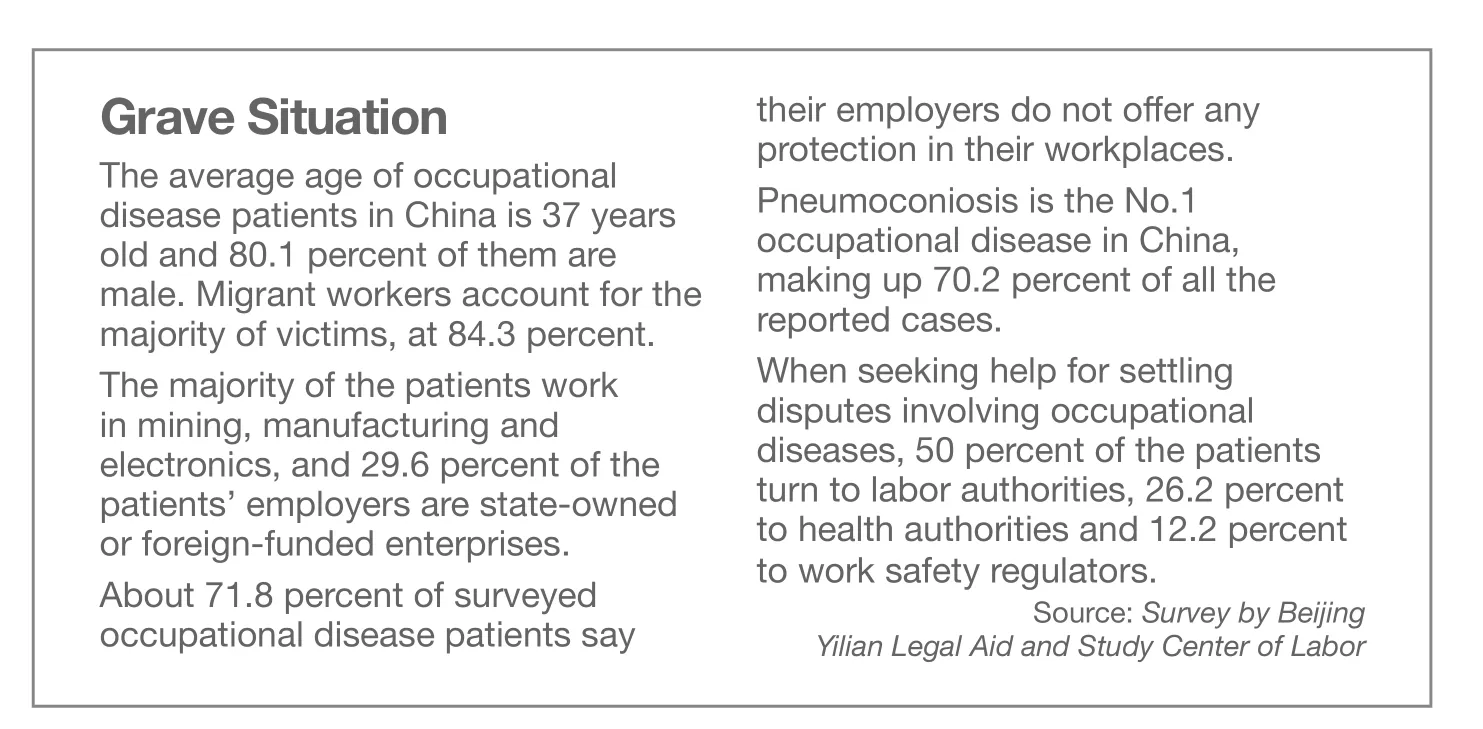Injury at Work
2011-10-14ByJINGXIAOLEI
By JING XIAOLEI
Injury at Work
By JING XIAOLEI
Much more needs to be done to tackle the grim situation of occupational diseases
It seems everybody loves cool gadgets like the iPhone and iPad manufactured by Apple Inc. However, there is constant darkness behind the shining glory.
For the latest instance, Apple released its Supplier Responsibility Progress Report 2010 in February, admitting that 137 workers at the Suzhou facility of Wintek, one of Apple’s suppliers in China, had suffered adverse health effects as a result of exposure to n-Hexane, a chemical found in products used to clean the touch screen of Apple’s iPhone products.
The Apple-involved scandal again focused a spotlight on the issue of occupational diseases, which have taken the lives of 137 gold mining workers in Shangshan Township in Xiushui County, Jiangxi Province, since 1994 when the pneumoconiosis was fi rst detected there.
“It’s a land that has been cursed,” said an anonymous medical expert after he had inspected the township for pneumoconiosis,a deadly disease that is slowly killing local villagers. There have been 489 villagers diagnosed with the disease (137 already dead) and 152 suspected cases.
Pneumoconiosis, or what is sometimes dubbed as “black lung” disease, is a chronic disease caused by long-term exposure to coal dust and other harmful materials. A large number of Chinese miners, especially those working in small and medium-sized mining companies with substandard working facilities, fall victim to the disease. It is currently one of the most common occupational diseases in the country, said the Ministry of Health in April 2010.
In 2009, 18,128 cases of occupational diseases were reported to health authorities at all levels, up 32 percent over the previous year, the ministry said. Black lung disease cases accounted for 14,495 of them, representing an annual growth of 34 percent.
In that year, 124 migrant workers in Gulang County in Wuwei City, northwestern Gansu Province, were diagnosed with black lung disease. A third of them are in critical condition and three are already dead.
In July of the same year, Zhang Haichao,a factory worker from Henan Province, demanded doctors open his chest to con fi rm he had the occupational lung disease after the local health authorities denied him free treatment and compensation from the employer.
On a larger scale, the Ministry of Health released fi gures showing that about 200 million laborers face the threat of developing ailments in the workplace in about 16 million enterprises in which poisonous and harmful materials are used.
The ministry said it had recorded more than 500,000 cases of occupational disease or injury since 1978 and the number is rising.
The fragile network
“Though it’s a matter of life and death,occupational diseases are rarely acknowledged by the general public. Many mistake common office ailments, such as pain in the neck or lower back, as occupational diseases,” said Zou Wei, who works for the Occupational Disease Network, an influential website in China that is dedicated to providing information that’s related to working hazards and helping occupational disease sufferers obtain compensation and protect their rights.
“A real occupational disease is a chronic ailment that occurs as a result of work or occupational activities. Black lung,chemical and metal poisoning and radiation poisoning are the most common,” said Zou.“Learning what occupational diseases are is only the fi rst step to helping sufferers solve their problems.”
Poor public awareness put aside, the country’s abilities to prevent and treat occupational diseases are lagging behind needs.
A Xinhua report shows China has fewer than 500 medical institutions capable of diagnosing occupational diseases and 2,272 occupational health check-up centers. Only 12 of the 31 provinces, autonomous regions and municipalities on the Chinese mainland have independent prevention and control institutions for occupational diseases.
But, the government is picking up speed in strengthening medical facilities in this regard. At a working conference in February,Vice Minister of Health Chen Xiaohong urged all provinces to set up independent institutions for occupational diseases by the end of this year. He also required all prefecturelevel cities to set up check-up centers that can diagnose occupational diseases.
Uneasy compensation
There are more problems than the limited number of medical institutions to cure occupational diseases. The unusually lengthy procedures required for occupational disease diagnosis lead many patients to miss the opportunity to claim compensation from their employers.
In 2002, China enacted the Law on the Prevention and Control of Occupational Diseases to protect workers in high-risk industries. Employers and insurers are mandated to award patients compensation upon certification by government-designated oc-cupational disease control centers. But some regulations dictate patients must be diagnosed as having an occupational disease at a hospital, which could mean a process that could last for three months.

POOR PROTECTION: A female worker at a coalmine in Anhui Province wears only a gauze mask to guard against health-threatening coal dust
Patients also have to get local labor authorities to identify their diseases were caused by their current working environment, and such a procedure could last for months as well. Then they have to wait for another two to three months before their disability level caused by the recognized disease is rated.
It’s reported that Zhang Qiang, a former hotel worker, had to wait 1,461 days before receiving a work-related injury identi fi cation letter. The 56-year-old man had his feet and legs burnt by a toxic chemical while working for a state-owned hotel in Beijing. He said the wait was too heavy a burden. As a result, he was never properly compensated because of the long wait for the of fi cial documentation.
The Beijing Yilian Legal Aid and Study Center of Labor, an NGO that provides legal aid services for employees suffering from labor disputes for free, conducted a survey on occupational disease patients and the results came out in February. The survey found that 37.8 percent of the respondents didn’t get any form of compensation and there was a serious problem caused by delays in sending out documentation.
To get compensation from their employers, the patients need to have a work-related injury identi fi cation letter, and the center’s survey found that 57.8 percent of the respondents waited more than 30 days for such a letter.
“If everything goes smoothly, it will take nine months to go through the procedures.Many small factories will change their businesses in far less time than that, especially when they hear whispers of their workers getting sick,” Zou said.

“Actually, many occupational diseases might have long incubation periods. When some of the sickened employees fi nally realize they have suffered occupational diseases,they have already lost track of their employers,” he said.
In 2010, Zou’s website tried to help a patient with benzene poisoning in Bishan,a small county in southwestern Chongqing Municipality, win compensation for his medical treatment. The procedures took a year.When the patient fi nally had all the papers he needed, his boss vanished.
“Shortening identi fi cation procedures is vital to helping these patients get compensation in time,” Zou said.
Encouragingly, Zou said, the government had taken measures to shorten the procedure time in 2010, such as establishing diagnostic criteria for occupational diseases related to infection and radiation.

NEWSMAKER: Zhang Haichao, a factory worker from Henan Province, shows his medical certificates on July 27, 2009. In July 2009, Zhang demanded doctors open his chest to confirm he suffers an occupational lung disease after local occupational disease control center failed to recognize his worsening conditions
In addition to the long wait for papers, the patients are also having dif fi culty preparing the materials needed to apply for the occupational illness diagnosis. They are required to have laborer’s employment history, occupational disease inductive work records,occupational health examination results and occupational disease medical treatment among other individual health records.
“The most dif fi cult one is to get the occupational disease inductive records from their employers. Once a person is diagnosed as suffering occupational diseases, the employer may have to take compensation responsibility. Therefore some employers refuse to provide such medical records or even deny the labor relation with the patients,” said Ye Mingxin, director of the center.
The survey by the Beijing Yilian Legal Aid and Study Center of Labor showed 48 percent of the respondents have been turned down by the occupational disease control centers on the grounds that the applicants don’t possess enough and necessary materials.
Progress
Last November, the Legislative Affairs Of fi ce of the State Council published the draft regulation concerning occupational disease diagnosis and asked the public to give feedback.
According to a statement issued along with the regulation, in determining whether a patient suffers from an occupational disease,information about workplace hazards is needed. The new regulation says a diagnosis can be performed, even if employers do not provide information or provide falsi fi ed information.
It stipulates, if employers do not provide information, or patients question the authenticity of such information, patients can apply for arbitration of labor disputes and arbitration authorities should handle the case within 30 days.
And the regulation says employers will be held liable if they fail to provide relevant information within the time period designated by the arbitration authorities.
